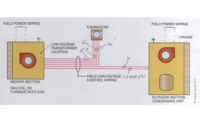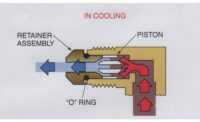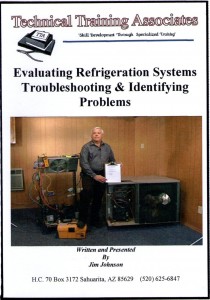Bob is a service technician who is well trained and nationally certified. However, he has sometimes suffered from the same confusion that all technicians occasionally do — the facts that he gathers may or may not point to the obvious cause of the problem or the best solution. But Bob has had something that no one else has. He recalled his long-time HVACR mentor and imagines him accompanying him as “Btu Buddy,” someone who reminded him to take time to stop and think before rushing to judgment, helping keep him on the right track, even with facts that are confusing.
Now, Bob’s company has promoted him to help train a new employee, right out of a school specializing in HVAC, just like Bob was. Bob is now Tim’s Btu Buddy. Tim is anxious to travel with Bob. Tim realizes that he is right out of school, with the theory and lab work that he accomplished in school, but still needs help. He knows that he worked with many of the components of the systems in the school, under ideal conditions with good light and air conditioning. Now it is into the field, sometimes under the house with poor lighting, or out on the rooftop in the sun, where the real action is. He is naturally and normally reluctant, but he has Bob to help guide him.
Bob and Tim were on their way to a no cooling call, their first of the season, when Tim asked, “Wonder why we would have a no cooling call this time of year? It is only 75°F during the day and 40° at night.”
Bob explained, “Some residences may have large windows facing the south. Notice that the sun shines fairly strong on south facing structures this time of the year. Later in the summer, the sun will be almost directly overhead and shine on the roof. A south facing wall will let a lot of solar heat load soak into the structure, particularly if there is a lot of window exposure.”
They arrived at the house at about 12:30 p.m. and Tim said, “You nailed that on the head. Look at that house. It has huge windows and the sun is shining directly on them. I bet it does get warm in that house.”
They talked to the homeowner and she said, “The air conditioner worked yesterday afternoon. It was the first time we had used it. This morning, as the morning warmed up, the house became warm. I don’t believe the air conditioner is working, even though I hear it running.”
Bob and Tim went to the room thermostat and Tim said, “It is set at 72° but the thermometer says that it is 76°. She is right; something is not right. What is next?”
Bob said, “Let’s go to the air handler first and see what is happening there. It sounds like the filter may be stopped up.”
They went to the air handler which was in the garage and Tim said, “Look at the ice on the suction line fittings.”
Bob said, “I want you to look this system over and tell me what to do and what you think.”
Tim said, “The first thing that we must do is thaw the evaporator so that air can pass through it. I am going up to:
1. Go to the thermostat and turn the compressor off and the fan to the ‘fan on’ position to let the evaporator thaw. That will take at least 30 minutes.
2. Then I am going to check the air filter to see how dirty it is.
3. Then I am going to check the air registers and make sure that they are all open.
4. Then I am going to make sure that the return air is not blocked in any way.
5. Then I am going to check the condensing unit.”
Bob said, “After you do all of that, tell me what you see and explain why the unit is frozen up.”
It took Tim about 20 minutes and he came back to Bob and said, “The coil was completely blocked with ice. The supply registers were all open and the return air is not blocked; there is a single return air register in the hall. The suction line is frozen all the way back to the compressor and the compressor was a block of ice.
“I didn’t see any reason for the freeze up unless the system is low on refrigerant. Should I install the gauges?”
Bob said, “No, let’s wait until we start the system after it is thawed, and then we will see what we think. Let’s change the air filter and oil the condenser fan motor and check it out.”
Tim then said, “When we arrived, I noticed the condenser fan was making a lot of noise. I think it may be defective.”
They went to the condenser and looked it over when Tim said, “Look at the fan bracket. It has four bolts and two of them seem loose. Maybe that was the noise I heard.”
Bob said, “Look at the water coming out of the condensate drain and the compressor is not running. That is melted ice from the evaporator. That ice is thick, but it has a lot of air in it and will melt fast.”
They tightened the fan bracket bolts and oiled the motor. Then they went back inside and checked the airflow. There seemed to be plenty of air flowing, so Bob said, “Start the compressor back up and put the fan switch back to automatic. Then let’s go outside to the condensing unit and see what it is doing.”
They went to the condensing unit and looked it over again. The fan was not making noise and all seemed well and Bob asked, “How does the refrigerant charge look to you, Tim? Does it seem to have the correct charge? Feel the suction line.”
Tim felt the suction line and said, “It doesn’t seem like it is cool enough.”
Bob then asked, “What is the design temperature for most air conditioning units to operate at full load?”
Tim said, “They are designed to operate at 95° at full load.”
Bob said, “It is 75° outside now. Would that affect the reading?”
Tim said, “That would cause a low head pressure.”
Bob then said, “This unit uses an orifice metering device. What would low head pressure do with an orifice metering device?”
Tim said, “It would cause the orifice to under feed the evaporator, and it would cause a high superheat and a warmer than normal suction line.”
Bob said, “What can you do about that?”
“We can partially block the condenser airflow to get the head pressure to rise and see if that lowers the suction line temperature,” said Tim. “I am going to block the condenser (Figure 1).”
After a few minutes, Tim said, “The suction line is really getting cold. I believe the unit has enough refrigerant charge, and we didn’t have to install the gauges and risk a leak.”
Bob then said, “Now for the big question: What caused the unit to freeze up?”
Tim said, “From what we have seen, I believe that the owner turned the unit to cool yesterday and set the thermostat to 72° and the unit operated OK all day. The unit turned on and off as it should. As night time approached, the unit continued to operate and shut down as it should until the outside air cooled down last night. Then the evaporator began to freeze between cycles until it eventually froze solid and could no longer cool the residence so the thermostat continued to call for cooling and when we arrived, it was not cooling the residence at all. The coil airflow was completely blocked.”
Bob said, “Good job, Tim, and a great explanation. It was a simple fix; it just took a little time. You will get a lot of calls from customers this time of year. Oftentimes they can be solved with a phone call to the customer by asking them:
1. Is the unit running all of the time?
2. Does there seem to be airflow?
3. If there is no airflow, tell them to shut off the compressor and turn on the fan for an hour.
4. Then ask them to turn the unit on and call you with the results. If it still isn’t cooling, you can do a service call.”
Bob noted, “This is particularly good practice when your time is very short due to a lot of backlog of service calls and you can’t get there quickly.”
Tim then said, “Those are good ideas. When service calls are backed up, the customer can really get impatient for service. If you save them the price of a service call, they will be loyal to you.”
Bob asked, “Is there anything else that we should do on this call?”
Tim said, “We didn’t oil the evaporator fan motor. If we do that, we have done a complete spring service on this unit.”
Bob said, “You are right; we should do it all while we are here.”
Publication date: 4/21/2014
Want more HVAC industry news and information? Join The NEWS on Facebook, Twitter, and LinkedIn today!










